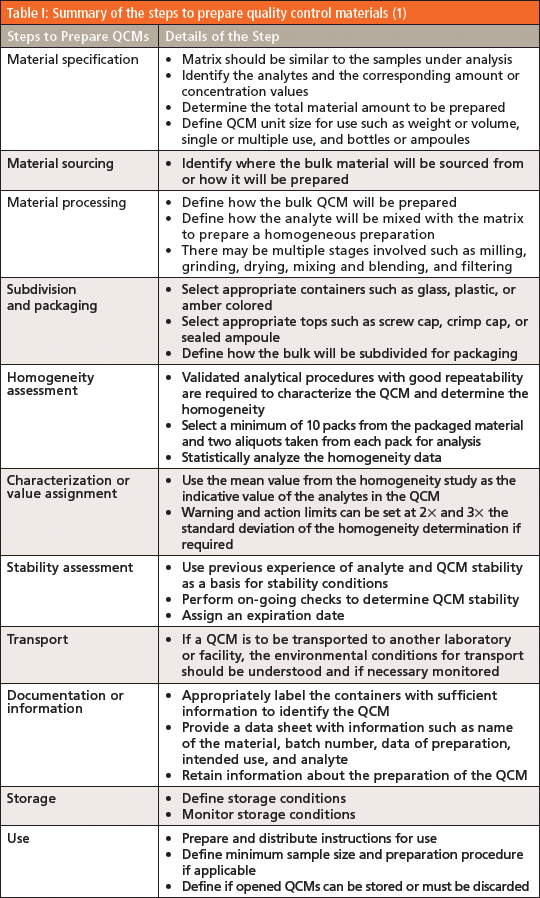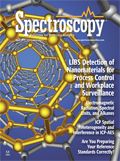How Do You Prepare Reference Standards and Solutions?
This month we discuss ISO Guide 80, "Guidance for the In-House Preparation of Quality Control Materials." This practical guide is worth reading, and its contents should be compared with your current working practices. In addition, we look at options for the preparation of working solutions from stock solutions to see the errors that could occur.
Volume 30 Number 4 Pages 14-17
This month we discuss ISO Guide 80, "Guidance for the In-House Preparation of Quality Control Materials." This practical guide is worth reading, and its contents should be compared with your current working practices. In addition, we look at options for the preparation of working solutions from stock solutions to see the errors that could occur.
In August 2014 the International Standards Organization (ISO) published Guide 80 entitled "Guidance for the In-House Preparation of Quality Control Materials (QCMs)" (1). The guide consists of 18 pages of guidance plus six appendices of worked examples for a variety of examples such as coal, geological or metallurgical, wheat flour, bauxite, pharmaceutical, and bromate in water quality control materials. Appendix 5 is of particular interest to this column because it looks at the preparation of pharmaceutical reference standards.
Reference Standards and Solutions
The preparation of reference standards is an essential function within virtually all laboratories carrying out quantitative and qualitative analysis. The majority of analytical techniques used are comparative rather than absolute; that is, the sample response is compared with that of a standard preparation to quantify the amount of analyte present in the sample. Therefore, the preparation of reference standards is of paramount importance to any quantitative analysis. This is the focus of the first part of this column.
After the quality control material (QCM) has been prepared, it is typically used by preparing a stock solution that is stored until the expiration date has been reached and then it's discarded. From the stock solution, a working solution is prepared on the day of analysis and then it is usually discarded after the analysis has been completed. Errors introduced to the preparation of a working standard should be as few as possible to minimize the uncertainty of the overall analytical procedure. This topic will be discussed in the second portion of this column.
What Do You Mean By . . . ?
Returning to the initial topic of this column, there are two terms used by ISO Guide 80: certified reference material (CRM) and QCM. What are these terms and how are they related?
- CRM: Certified reference materials have values of specific analytes with associated uncertainties assigned by metrologically valid procedures and are primarily used for method validation and calibrations. These materials have metrological traceability (1). Typically, CRMs are produced by laboratories that are accredited to ISO Guide 34 for the preparation of such materials (2) as well as following the principles of ISO Guide 35 for the certification (3).
- QCM: Reference materials that are sufficiently homogeneous and stable are necessary for metrological quality control purposes, such as demonstrating a measurement system is under statistical control, performs as expected, and provides a reliable result; with QCM the trueness of the measurement result is not critical (1).
QCM was the term devised specifically for ISO Guide 80 to cover all equivalent phrases used in different industries such as in-house reference standard, quality control standard, and so on. The main criteria for a QCM are that it is a homogeneous material, the analytes of interest are stable, and the stability of the analytes of interest is known.
Now that we have the terminology defined, we can have a look at the process for specifying and preparing a QCM.
Specification and Preparation of QCMs
The main part of ISO Guide 80 deals with the process of specification and preparation of in-house reference standards or QCMs. The left column in Table I presents the steps required for preparing QCMs and the right column lists some of the details for each step. Please note that this is not a thorough description of all the items - you'll need to read ISO Guide 80 (1) to gain the full understanding of the contents.

The guide provides a practical and general approach for the preparation of in-house reference materials. That discussion is followed by six case studies to illustrate how the principles of the guide can be applied in specific circumstances.
Preparation of Pharmaceutical QCMs
Annex E of ISO Guide 80 covers a case study of pharmaceutical reference standards; however, readers looking for explicit guidance will not find it here. A case study it is not. The basic material for this annex has been provided by scientists from the pharmaceutical industry, but the guidance reads as a generic approach as the annex states in section E2.1 "There is no magic bullet and every situation is different" (1). However, there is a little more information within the framework offered by the main part of the guide. Table I presents clarification of how a QCM can be specified and prepared for the pharmaceutical industry for small heterocyclic molecules. For example, the QCM is sourced in the early phases of a project from laboratory production then from pilot plant material during the later phases of the project. Characterization of the QCM is discussed from the perspective of organic impurities, inorganic impurities, and residual solvents and some of the issues with the analytical techniques involved with characterization of the material.
Preparing Your Reference Stock Solution
Now that the QCM is prepared and released for use, stock reference solutions can be prepared from it. An aliquot is carefully weighed on an analytical balance and the weighing vessel is transferred to the volumetric flask. The material is dissolved and then made up to the mark as per the analytical procedure. The flask is labeled according to the quality or regulation requirements and stored under the predefined storage conditions. So far, this is pretty straightforward. The fun comes when the working solutions are prepared for use on the day.
How Accurate Are Your Dilutions?
Once you have prepared your stock solution, you'll typically make a dilution or dilutions from it to prepare working concentration solutions for the analysis on the day of. How will you do this? A recent paper by Burgess in Pharmaceutical Technology (4) looked at the impact of various simple and serial dilution schemes on the accuracy of prepared reference standard solutions. The paper only considered using grade A volumetric glassware, of course!
Using the example provided, a stock solution of 50 mg/L, the analytical procedure required a 1-mg/L working solution - a 1:50 dilution. The question posed in the column was: What is the best way to perform this dilution volumetrically? Or put another way: Which dilution approach provides the required working solution with the smallest error? Looking at a straight 1:50 dilution (ranging from 1 mL in a 50-mL flask to 20 mL in a 1-L flask), Burgess came to the conclusion that the bigger the pipette and the bigger the flask is, the lower the relative standard uncertainty. Comparing the range of dilutions, the 20 mL to 1000 mL dilution has a factor of four lower error than the 1 mL to 50 mL dilution. These figures were based on the known errors using grade A glassware.
However, Burgess also posed the question: What happens if serial dilution was used instead? This approach would save solution and solute usage. One option was to take a 10-mL volumetric flask and serially diluting the stock solution first 1:5 followed by a 1:10 dilution. Both dilutions would involve pipettes and volumetric flasks. Here, the serial dilution uncertainty rises to 6× larger than the best 1:50 dilution (0.39% versus 0.06%). To understand the nuances of the process dilution you really should to read this column (4).
Summary
In this installment we looked at how to prepare quality control materials as outlined in ISO Guide 80. In addition, we have looked at the errors that are possible when diluting a stock standard solution to prepare daily working solutions for that day's analysis.
References
(1) ISO Guide 80, "Guidance for the In-House Preparation of Quality Control Materials (QCMs)," (International Standards Organization, Geneva, Switzerland, 2014).
(2) ISO Guide 34, "General Requirements for the Competence of Reference Material Producers," (International Standards Organization, Geneva, Switzerland, 2009).
(3) ISO Guide 35, "Reference Materials - General and Statistical Principles for Certification," (International Standards Organization, Geneva, Switzerland, 2006).
(4) C. Burgess, PharmTech39(1), 62–64 (2015).
R.D. McDowall is the Principal of McDowall Consulting and the director of R.D. McDowall Limited, as well as the editor of the "Questions of Quality" column for LCGC Europe, Spectroscopy's sister magazine. Direct correspondence to: spectroscopyedit@advanstar.com

R.D. McDowall
